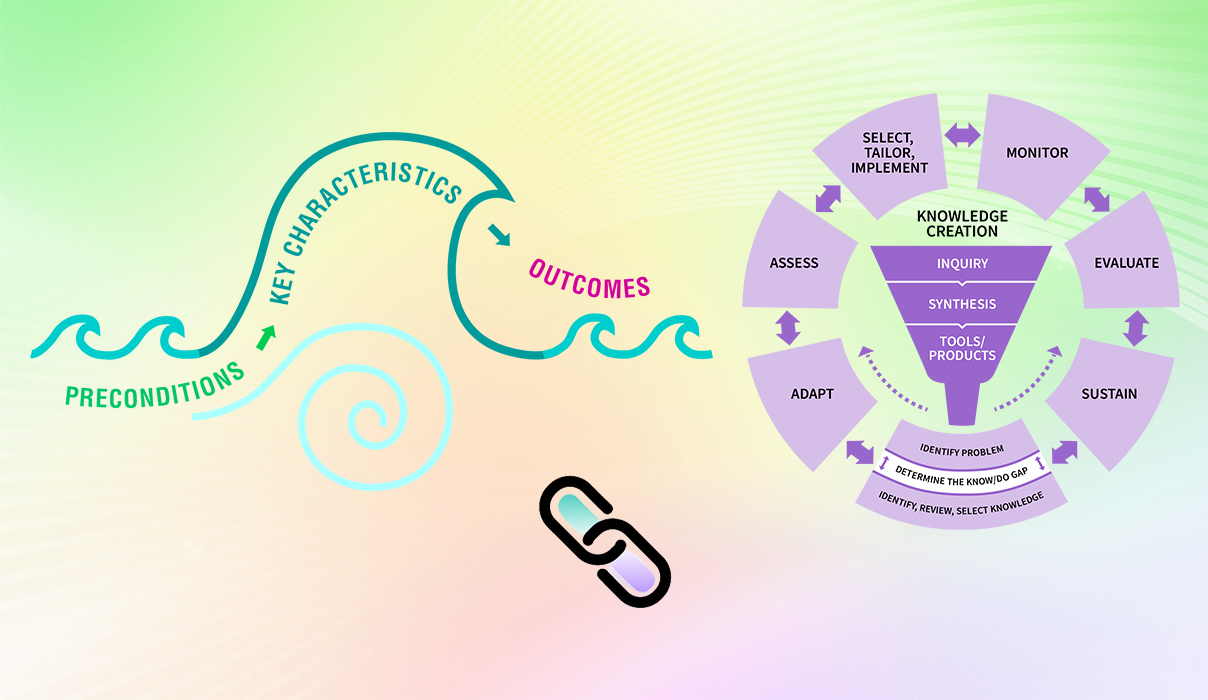Urgent need to take action
Index
Social movements in the context of knowledge uptake and sustainability include the key characteristic, “Urgent need to take action.” This reflects a push for addressing a shared concern (for example, reducing fall rates) or strongly desired change (for example, ensuring excellence in care). In this section, you and your change team will learn more about the pivotal nature of a shared concern in serving as the fuel to act (Grinspun, 2018; Grinspun et al., 2018a).

What is this element?
This element involves the recognition by individuals, groups and organizations that change related to the shared concern or strongly desired change must happen and cannot be ignored. There is a readiness to take action – maintaining the status quo is no longer optional (Bate et al., 2004b; Burbidge, 2017; Lippman et al., 2013).
The urgent need to take action can come from a desire to accelerate quality care, promote excellence or improve outcomes for patients/people. Or, sometimes the urgent need to take action results from the pressure that builds up and reaches a critical point for a shared concern or strongly desired change. Its speed can vary – it can happen slowly over time, or quickly with a catalytic event that forces action (Bate et al., 2004a; Bate et al., 2004b; Burbidge, 2017; Carson-Stevens et al., 2013; Grinspun et al., 2018a; Lippman et al., 2016; Sustainable Improvement Team and Horizons Team, 2018).
Urgent need to take action is…
shared by individuals, groups and organizations
- People feel an urgent need to take action for change.
- The pressure to take action builds through people’s interactions.
an ability to fix or address complex issues, improve quality or innovate
- The usual approaches to creating change are believed to be too slow and ineffective.
- New approaches must be used to scale up and speed up change. This gives people a sense of ownership and meaning, and provides direction for the change.
reflected in the vision or goals of the social movement
- People come together to create a shared purpose and common vision for how change can be achieved and what the impact could be.
- There is a commitment to the new vision and a belief that it is worth striving for.
SOURCES: Bate et al., 2004a; Bate et al., 2004b; Bibby et al., 2009; Burbidge, 2017; Campbell, 2020; Carson-Stevens et al., 2013; Davey, 2009; Grinspun et al., 2018a; Kennedy et al., 2019; Lippman et al., 2016; Ruglis and Freudenberg, 2010; Sustainable Improvement Team and Horizons Team, 2018.
Why is this element important?
Social movements drive action. Once people recognize an urgent need for change – one of the preconditions of a social movement – they feel they must take action, and do so together.
They engage their internal drive – or intrinsic motivation – and their commitment to getting started on achieving change through mobilized individual and collective action (Bate et al., 2004a; Bate et al., 2004b; Carson-Stevens et al., 2013; Grinspun et al., 2018a; Sustainable Improvement Team and Horizons Team, 2018).
Case studies

Applying focused strategies and training to achieve a timely change
Staff at the Birchmount and General site locations of Scarborough Health Network (SHN) in Toronto, Ontario, Canada are committed to providing excellence in clinical care. At this Best Practice Spotlight Organization® (BPSO®) Best Practice Spotlight Organization (BPSO) – Scarborough Health Network (shn.ca), there was a strong interest and shared concern from staff and leadership teams on the prevention of bullying in the workplace.
In response, they chose to focus on anti-bullying as an area for improvement. To do so, they implemented the Preventing and Managing Violence in the Workplace Best Practice Guideline (RNAO, 2009). Collaborative efforts from the interprofessional team contributed to developing targeted strategies and training, leading to effective action.

Advancing the global Black Lives Matter movement to end systematic racism
The urgent need to end systemic racism gained international traction following the death of George Floyd. Support for the global Black Lives Matter movement increased, leading to national and international discussions on structural racism and demands to address long-standing problems of police brutality. Calls to action included defunding the police and a global movement for justice, freedom and liberation.

Transforming long-term care reform
The urgent need to transform long-term care (LTC) in Ontario gained broad support in 2020 during the COVID-19 pandemic. The pandemic exposed long-standing system failings. Examples of triggers included:
- an alarming mortality rate resulting from COVID-19 in LTC settings, representing a large majority of COVID-19-related deaths in Ontario
- a scathing report from the Canadian Armed Forces
- devastating stories from families who were separated from loved ones
Considerations for getting started
Here are some considerations for you and your change team to get started:
Define the shared concern or desired change with interested people.
Use data, literature, case studies or personal stories to highlight the importance of the concern. This builds credibility and connects with people’s hearts and minds. The shared concern or strongly desired change should reflect people’s beliefs, values, emotions, and why they think the issue is important (Grinspun et al., 2018b). Find more ideas in the Framing section.
Create neutral spaces.
In order to inspire change and action, people will need the space to speak freely and honestly. They will need to feel safe if challenging current practices or senior management perspectives.
Highlight the opportunity for change.
Help people see your vision for change. Even if you do not yet have a fully-thought-out strategy, sharing your vision for change will motivate people to get involved (Grinspun, 2018).
Create a shared purpose - address the "why".
Meet with others to talk about your vision and what exactly needs to change. Determine not just what you want to achieve, but why this is personally and collectively important and why your solution or proposed action is the correct approach (Bate et al., 2004a; Serna Restrepo et al., 2018; Sinek et al., 2017).
Develop an action plan.
Once you’ve identified and collected goals, set up working groups to help develop your strategic plan for action. In cases where you are planning for a healthy public policy change using evidence and advocacy, it can be helpful to use an action plan that applies elements of social movement actions such as knowledge mobilization, grassroots and coalition building, mass and social media, and direct advocacy (Grinspun, 2007; Herechuk et al., 2010).
Accelerate your success: The Knowledge-to-Action Framework’s "Identify the problem" action cycle phase includes guiding to support decision-making regarding priority areas for change where there exist evidence-informed gaps between current practices and best practices. Determining priority areas for change can be especially helpful for situations with complex problems that have multiple components. Choosing priority areas for action that are seen by others as feasible and achievable can help build support and momentum for the social movement. Visit Determining the knowledge-to-practice gap (know-do gap) to find out more.
Practice tips
People will be more likely to join a social movement if they perceive that:
- the need to take action is urgent
- the social movement is likely to succeed
- the first steps to take action are clear
People might be hesitant to join a social movement at the outset. This is because uncertainty about how the social movement will unfold can cause some pushback. Indeed, the early stages of a social movement may appear disorganized without clear direction or goals. However, this level of uncertainty is normal and reflects the non-traditional approach to change.
If you find people are hesitant to join your social movement, you can present any stress or fears related to the change as tolerable and manageable. Consider also the following:
- Point out to people you wish to join the movement that friendships and social ties may develop. People often join a social movement to be part of a group, to have a sense of belonging and to feel a part of a larger community.
- Present the social movement as an opportunity or challenge, which will foster positive emotions. If people perceive that joining a social movement might provoke negative emotions or cause them some type of harm, they will be less likely to engage.
Overall, change is possible but it may take time and patience. Creating a shared purpose usually occurs over time with discussions among a variety of people. And expect some disagreements – this is normal in change processes.
SOURCES: Bate et al., 2004a; Burbidge, 2017; Serna Restrepo et al., 2018; Sustainable Improvement Team and Horizons Team, 2018.
The importance of relationship-building: "Movements are built by the formation of new relationships among people. People move people, and people are moved by examples of people moving people. The ‘skilled, intentional, purposeful forming of relationships’ on which social networks can be built is essential to the success of social movements—especially insurgent ones.” (Ganz, 2014)
Navigating common problems
Here are some examples of common problems you and your change team may experience and some suggested strategies:
No action is taken despite people recognizing that change is needed.
Your organization blocks attempts at initiating change.
There are competing priorities for change.
Conflicts arise.
SOURCES: Burbidge, 2017; Ganz, 2014; Sustainable Improvement Team and Horizons Team, 2018.
Check your progress
- You develop a sense of shared purpose with some early goals and an emerging vision for the social movement.
- You have meetings to discuss the shared concern or the strongly desired change.
- You have a deepened understanding of the complexity of the situation, concern or problem; the vision for the social movement addresses this complexity.
- Others begin to feel a sense of community and begin participating in the social movement.
- Collaboration, trust and social bonds between change agents and others are becoming evident.
SOURCES: Bate et al., 2004a; Burbidge, 2017; Grinspun et al., 2018a; Serna Restrepo et al., 2018; Sustainable Improvement Team and Horizons Team, 2018.
Linking this key characteristic to other framework components

Linking to the other elements of the Social Movement Action Framework:
Each of the elements of the Social Movement Action (SMA) Framework is dynamic and interrelated. For example, the shared concern, goals and vision of the social movement can be communicated through framing. The people that take part in change are intrinsically motivated. As the social movement evolves, formal and informal leaders emerge. The need for change drives forward momentum and supports individual and collective action that is held in public spaces to increase visibility.
Linking to the action cycle phases of the Knowledge-to-Action Framework:
You and your change team’s capacity in social movement actions may be enhanced or accelerated by adding in some of the action cycle phases of the Knowledge-to-Action (KTA) Framework, as the two frameworks are complementary. In addition to the linking example described earlier in this section, there can be many other points of connection between the two frameworks. Here are two examples:
- Identify the problem: By using the KTA Framework, you can clearly outline the existing issue of concern for you and your change team. Identifying the problem links back to the two main forces that drive the urgent need to take action:
- building pressure for a shared concern or a strongly desired change to be addressed
- creating a point of interaction within your team or amongst other staff to recognize the need for change.
- Adapt knowledge to local context: Some questions to ask yourself and your change team to decide how this urgency can or can’t be mobilized in your setting: Does the shared concern get interpreted across local contexts by different groups of stakeholders? Does it manifest differently? Is the urgent need and readiness to take action to address this concern uniformly shared across different groups and contexts?
- For more discussion about the dynamic links between the elements of the SMA Framework to one another and to the KTA Framework, see the section "Two complementary frameworks".


